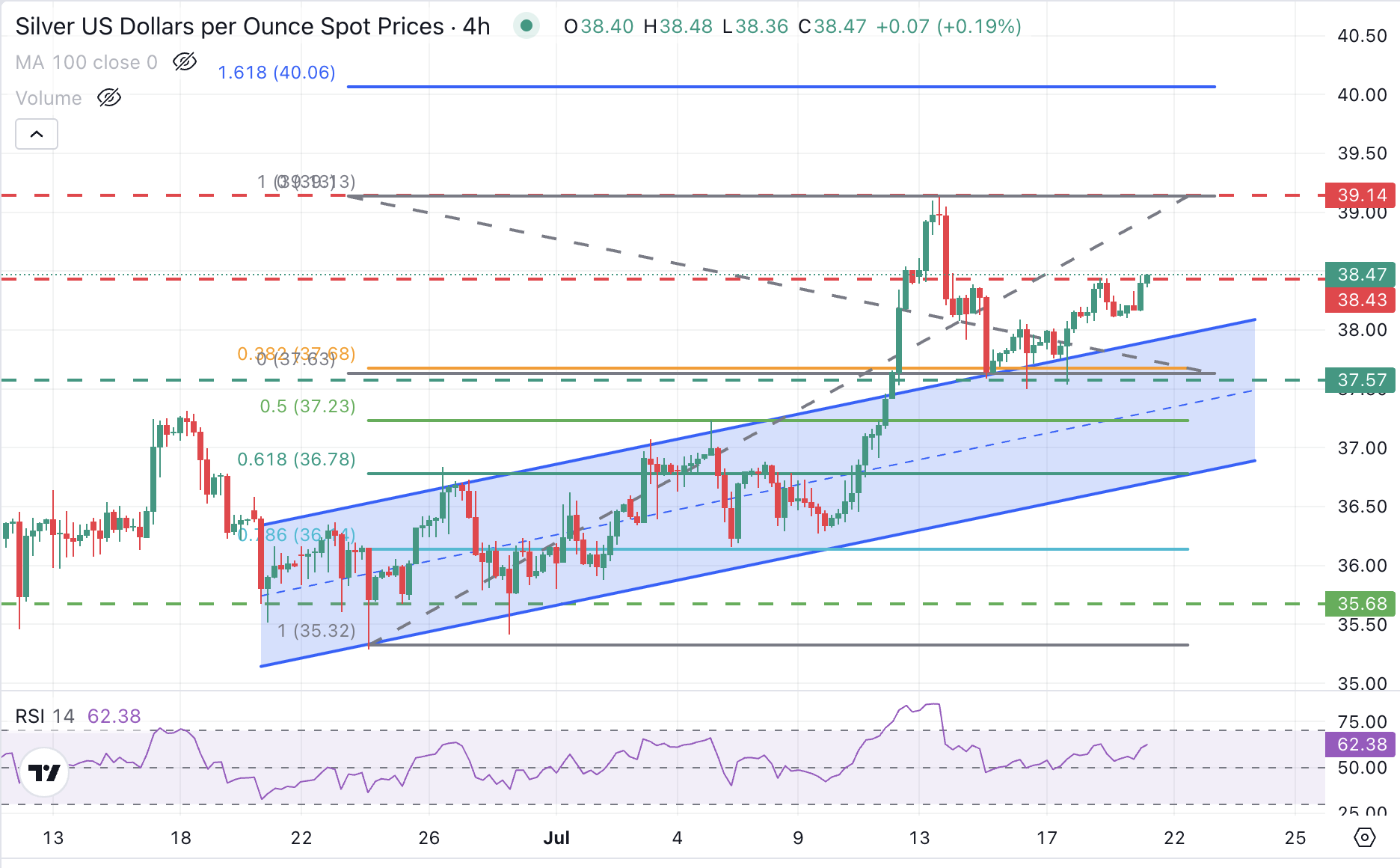Silver Price Forecast: XAG/USD resumes its uptrend and tests $38.45 resistance
- Silver advances further to test the resistance area at $38.45..
- A softer US Dollar and the retreating US Treasury yields are supporting precious metals on Monday
- XAG/USD maintains its broader bullish trend intact with key support at $37.60 area.
Silver (XAG/USD) is trading higher, following a slight decline on Friday. The precious metal is dragging support from a somewhat softer US Dollar and the retreating US Treasury yields to extend gains and test resistance at the $38.45 area at the time of writing.
Investors’ sentiment has improved somewhat in a relatively calm start to the week on the European market. A moderate risk appetite is weighing on the US Dollar Index, and lifting precious metals, favoured by their inverse correlation with US Bond yields and the US Dollar.
Technical Analysis: The longer-term bullish bias remains in play

XAG/USD´s reversal from long-term highs above $39.00 found support above the top of a previous bullish channel at the $37.55-$37.65 area last week. It has been moving higher for three of the previous four trading days.
The pair is now testing resistance at $38.45 (the July 15 and 18 highs), which closes the path to the July 14 top at $39.14. Above here, the 161.8% Fibonacci extension of last week’s pullback is at the $40.00 psychological area.
A rejection from current levels might find support at the mentioned trendline, now at $37.90, ahead of the July 15, 16, and 17 lows, which meet the 39.8% retracement of the June 24-July 14 rally, at $37.60.
Silver FAQs
Silver is a precious metal highly traded among investors. It has been historically used as a store of value and a medium of exchange. Although less popular than Gold, traders may turn to Silver to diversify their investment portfolio, for its intrinsic value or as a potential hedge during high-inflation periods. Investors can buy physical Silver, in coins or in bars, or trade it through vehicles such as Exchange Traded Funds, which track its price on international markets.
Silver prices can move due to a wide range of factors. Geopolitical instability or fears of a deep recession can make Silver price escalate due to its safe-haven status, although to a lesser extent than Gold's. As a yieldless asset, Silver tends to rise with lower interest rates. Its moves also depend on how the US Dollar (USD) behaves as the asset is priced in dollars (XAG/USD). A strong Dollar tends to keep the price of Silver at bay, whereas a weaker Dollar is likely to propel prices up. Other factors such as investment demand, mining supply – Silver is much more abundant than Gold – and recycling rates can also affect prices.
Silver is widely used in industry, particularly in sectors such as electronics or solar energy, as it has one of the highest electric conductivity of all metals – more than Copper and Gold. A surge in demand can increase prices, while a decline tends to lower them. Dynamics in the US, Chinese and Indian economies can also contribute to price swings: for the US and particularly China, their big industrial sectors use Silver in various processes; in India, consumers’ demand for the precious metal for jewellery also plays a key role in setting prices.
Silver prices tend to follow Gold's moves. When Gold prices rise, Silver typically follows suit, as their status as safe-haven assets is similar. The Gold/Silver ratio, which shows the number of ounces of Silver needed to equal the value of one ounce of Gold, may help to determine the relative valuation between both metals. Some investors may consider a high ratio as an indicator that Silver is undervalued, or Gold is overvalued. On the contrary, a low ratio might suggest that Gold is undervalued relative to Silver.

